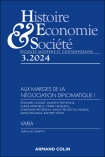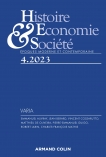
Histoire, Économie & Société (2/2019)
Pour acheter ce numéro, contactez-nous
Recevez les numéros de l'année en cours et accédez à l'intégralité des articles en ligne.
Si l’histoire religieuse et sociale s’est depuis longtemps penchée sur l’impact urbain des ordres religieux nés ou réformés dans le sillage du concile de Trente (1545-1563), la question a largement échappé à l’historiographie architecturale de la période moderne. Seul l’urbanisme civil, monarchique ouédilitaire, a droit de cité dans les études de référence, à commencer par l’ouvrage devenu classique de Pierre Lavedan, L’Histoire de l’urbanisme, Renaissance et Temps modernes (1959). Est-ce à dire que la notion « d’embellissement » serait restée à cette époque étrangère aux autres acteurs de la cité, privés ou religieux ? L’histoire architecturale de l’ordre de la Visitation Sainte-Marie montre qu’il n’en est rien. L’inventaire monumental des 135 couvents de la Visitation recensés avant la Révolution, allié à l’exploration systématique des fonds documentaires, publics comme privés, apporte un éclairage inédit sur l’irruption massive des ordres nouveaux au cours de la première moitié du XVIIe siècle. Il ne s’agit pas ici de traiter l’aspect foncier de cette « invasion » ni les stratégies de conquête immobilière des couvents, mais de proposer quelques éléments de réflexion sur ses implications formelles ou symboliques, à travers la politique architecturale d’un grand ordre féminin de la Réforme catholique.
While religious and social history has long been concernedwith the urban impact of religious orders born or reformed in the wake of the council of Trent (1545-1563), the question has largely escaped the architectural historiography of the modern era : only civil, monarchical, or municipal town planning, has the right to be cited in studies of reference, beginning with Pierre Lavedan’s classic work L’Histoire de l’urbanisme, Renaissance et Temps modernes (1959). Is this to say that the notion “embellishment” remained foreign to the other city actors, whether in the private or religious sector ? Thearchitecturalhistory of a large women’sCatholic reform order, the Order of the Visitation of Holy Mary, shows clearly that this is notso. The enormousinventoryof the 135 convents listed on the census of the national territory before the Revolution, combined with the systematic exploration of documentary records, public and private, shed new light on the massive irruption of new orders throughout the first half of the 17th century. The subject here is not the land aspect of this “invasion” nor is it the convents’ strategies of real estate conquest, but rather to propose some elements of reflection on the formal or symbolic implications through the architectural politics of a large women’s Catholic reform order.

